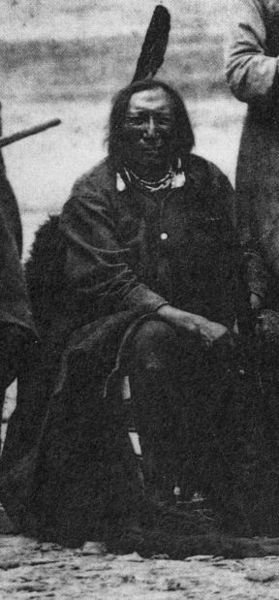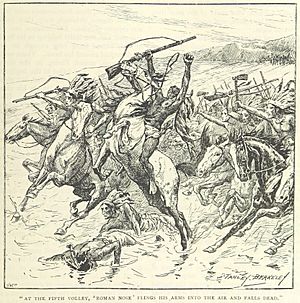Hook Nose facts for kids
Roman Nose (born around 1823 – died September 17, 1868) was a famous Native American warrior of the Northern Cheyenne tribe. He was also known as Hook Nose (Vóhko'xénéhe). Many people consider him one of the bravest and most important warriors during the Plains Indian War in the 1860s. When he was young, he was called Môséškanetsénoonáhe ("Bat"). Later, he took the warrior name Wokini, which non-Native people called Roman Nose. He was thought to be unbeatable in battle. His fighting skills were so well-known that the U.S. military sometimes mistakenly thought he was the main Chief of the entire Cheyenne nation.
Contents
A Cheyenne Warrior's Life
Hook Nose was born around 1830. He belonged to the Northern Suhtai, a group within the Northern Cheyenne tribe. It's important not to confuse him with other Native American leaders who might have had similar names.
After the terrible Sand Creek massacre in November 1864, Hook Nose became a very important figure among his people. He led attacks to get revenge on Euro-American settlements. These attacks happened at places like the Battle of Julesburg along the Platte Road and in areas of Wyoming, Nebraska, Kansas, and Colorado. Some historians say that Hook Nose attacked more settlers along the Oregon Trail between 1860 and 1868 than almost any other warrior.
Even though he was very influential, Hook Nose was never a chief. He was also not a leader of any of the six Cheyenne military groups. However, all Plains Indians knew him as a great warrior. He was seen as the main leader during battles. His reputation grew so much that white settlers believed he started most of the fights between the Cheyenne and the U.S. military. Hook Nose was a member of the Crooked Lance Warrior Society. He always turned down offers to become a Cheyenne Chief or headman. He never held a position of formal authority within his tribe.
Hook Nose was a very tall and strong man. Many historical stories describe his colorful and intimidating personality, as well as his amazing fighting skills. A doctor named Isaac Coates saw Hook Nose meet with General Winfield S. Hancock in 1867. Coates wrote that Hook Nose was one of the finest-looking men of his people. He was about six feet tall, with a strong body. He looked very military, especially because he wore a general's uniform. He carried many weapons and rode a fine horse. Coates said Hook Nose looked like the "God of War" and clearly didn't care if they talked or fought.
Hook Nose did not agree with making treaties with the United States government. Other leaders wanted peace, but he wanted to protect his people's land. After the Little Arkansas Treaty in 1865, Hook Nose moved south. He promised to help his friends, like Bull Bear and Grey Beard, and the Cheyenne Dog Soldiers. He wanted to defend their traditional hunting grounds along the Smoky Hill River and in the Republican Valley.
He was killed by American soldiers during the Battle of Beecher Island on September 17, 1868. He died while trying to charge an island in the Arikaree River. He was trying to defeat General Forsyth's soldiers.
Americans mostly knew him as "Roman Nose." Some of his other names were Arched Nose and Woo-kay-nay. His people knew Hook Nose as someone who was dedicated and willing to protect them. He was known as a warrior with many clever and brave ways to fight his enemies. Hook Nose was also a very spiritual person. He practiced traditional Cheyenne medicine. Hook Nose and his friends believed this medicine protected him and made him such a great warrior.
He died during the Battle at Beecher Island in 1868. Even though he never accepted the role of chief, many of his people respected him as a leader. They saw him as a protector of their people and their land. Roman Nose was a leader of Indian warriors and a member of the Crooked Lance Society of the Cheyenne Indian Tribe. Hook Nose wanted to protect his people. However, non-Indians saw him as a dangerous man. They thought he was a "bad" Indian who wanted to remove white settlers from the plains. Hook Nose's leadership, battle tactics, and spirituality made him well-known. Even though he died fairly young, Hook Nose made a big impact on the West during his time.
Battle Tactics and Leadership Skills
Hook Nose's battle tactics and leadership skills were known not only by his tribe but also by others who met him. His bravery was natural and pure. His influence was huge because he was the recognized leader in war, even though he was not a chief. People who saw Hook Nose fight spoke highly of his tactics and leadership. A common battle tactic he used was to ride up and down the line of army troops. He would ride within rifle range, making them shoot their weapons and waste their ammunition. Hook Nose used deadly and effective tactics to protect himself, his people, and his culture. Roman Nose was a well-known Southern Cheyenne warrior. He is best remembered for his important role in fighting against white expansion in the West during the 1860s. Hook Nose did not accept the idea that the West was expanding and becoming industrialized. Giving in to the enemy did not seem to be an option for him.
Spiritual Practices and Beliefs
Hook Nose was known for being very spiritual. He spent many hours preparing his medicine, his mind, and his spirit. It is believed that he sometimes arrived late to battles. This was partly because he spent more time than usual praying for blessings and getting ready for war. Hook Nose would spend days on spiritual journeys to cleanse his spirit and gain strength through his medicine.
Not only was Hook Nose protected by the medicine he gained through ceremonies, but he also felt protected by his famous warbonnet. The medicine man Ice, later known as White Bull, made and gave him this warbonnet. It was also believed that his warbonnet and the medicine he practiced were why he was such a successful warrior.
Death and the Warbonnet's Rules
It was believed that Hook Nose and those around him were protected through his spiritual practices and his warbonnet. For his warbonnet to protect him, there were certain rules and rituals he had to follow. Some of these rules included never shaking hands with anyone and never eating food that had been prepared or served using metal. Hook Nose had complete faith in his warbonnet. He believed it had always protected him in battle.
Hook Nose and his fellow warriors believed that on the morning of the Battle of Beecher Island, Hook Nose's medicine had been messed with. Hook Nose felt that something was wrong. He said, "Something was done that I was told must not be done. The bread I ate was taken out of the frying pan with something made of iron... If I go into this fight I shall certainly be killed."
Several days before the Battle of Beecher Island, Hook Nose visited a nearby Sioux camp. There, he took part in a feast. During the feast, he ate some fry bread. However, the woman who cooked the bread had used an iron fork to take it out of the cooking pan. This broke one of the rules of his medicine.
As he left for battle, he found out about this. But he did not have time to do the special cleansing ceremony to fix his medicine. Because of this, he did not fight as he normally would. He preferred to watch the battle from a distance. During the battle, an older warrior named White Contrary criticized him for not participating. So, Hook Nose decided to enter the battle after all, even though he knew he might die. After putting on his war clothes, including his warbonnet, he led an attack on the island. He was shot at close range during the attack and died late that afternoon, near sunset.
Hook Nose's death had a terrible effect on the Cheyenne's efforts to defend their lands. Their fight mostly ended with the defeat of Tall Bull and the Dog Soldiers at the Battle of Summit Springs in July 1869.



